Gartner Top 10 Tech Trends For 2023: Metaverse, AI, Cloud
Gartner makes 10 bold predictions for the hottest technology trends in 2023—from the metaverse and super apps to sustainability and adaptive AI.
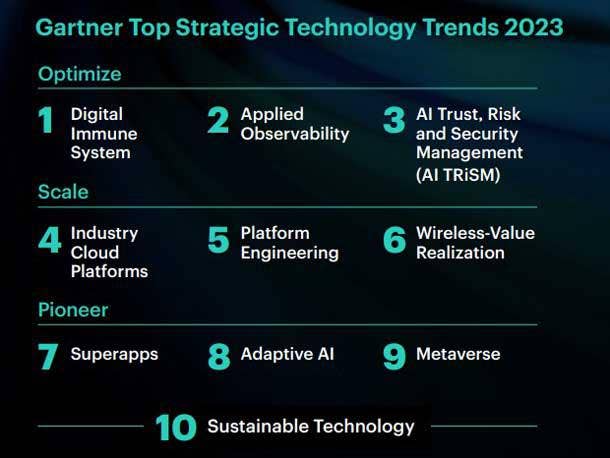
Gartner’s Biggest IT Trends And Predictions For 2023
From industrial metaverse use cases already in production to large cities leveraging cloud platforms to fix congestion and improve daily operations, technology is the key to solving some of the world’s most difficult problems.
IT research firm Gartner has unleashed its top 10 biggest technology trends and boldest predictions for the IT industry in 2023 and beyond.
For example, Gartner predicts by 2027 that over 40 percent of large organizations worldwide will use a combination of Web3, AR cloud and digital twins in metaverse-based projects aimed at increasing revenue.
Additionally, the research firm expects that in five years, 50 percent of the global population will be daily active users of multiple “super apps.”
[Related: Google Cloud Next: 10 BigQuery, Workspace, VMs, AI Launches]
In Gartner’s new report, ‘Top Strategic Technology Trends 2023,’ the firm takes a deep dive into the biggest IT trends next year and what businesses should expect.
David Groombridge, distinguished vice president and analyst at Gartner, said many business leaders are expected by now to be focused squarely on post-pandemic growth.
“Instead, most are now eyeing the threat of recession and managing the impact of persistent inflation, as well as dealing with crises in supply chain, energy sourcing and digital skills,” said Groombridge in a statement.
‘Delivering Technology Will Not Be Enough’
To enhance an organization’s financial position during economic uncertainty, IT leaders must look beyond cost savings to new forms of operations while also continuing digital transformation.
Gartner’s technology trends for 2023 revolve around three themes: optimize, scale and pioneer.
These three major themes help organizations optimize resilience, operations or trust, scale vertical solutions and product delivery, while pioneering new forms of engagement and opportunity.
“In 2023, delivering technology will not be enough,” said Gartner’s Groombridge. “These themes are impacted by environmental, social and governance expectations and regulations, which translate into the shared responsibility to apply sustainable technologies.”
Here are Gartner’s top 10 technology trends for 2023:
* Metaverse
* Digital Immune System
* Applied Observability
* Super apps
* Adaptive AI
* AI Trust, Risk and Security Management
* Wireless Value Realization
* Industry Cloud Platforms
* Platform Engineering
* Sustainability
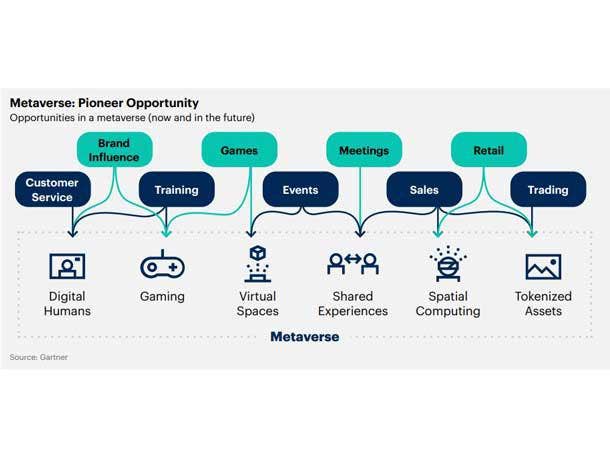
Metaverse
Gartner defines a metaverse as a collective virtual 3D shared space, created by the convergence of virtually enhanced physical and digital reality.
A metaverse is persistent, providing enhanced immersive experiences. Gartner expects that a complete metaverse will be device-independent and won’t be owned by a single vendor.
By 2027, Gartner predicts that over 40 percent of large organizations worldwide will use a combination of Web3, AR cloud and digital twins in metaverse-based projects aimed at increasing revenue.
The metaverse will have a virtual economy of itself enabled by digital currencies and non-fungible tokens (NFTs).
Metaverse Use Case: Siemens And Nvidia
Siemens has partnered with Nvidia to create an industrial metaverse. Clients can use the immersive environment to collaborate in creating innovative engineering solutions and solving problems involving digital twins, Internet of Things (IoT) and real-time analytics.
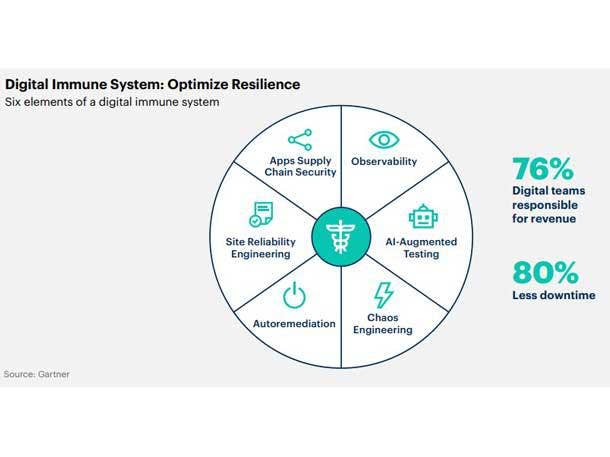
Digital Immune System
Gartner said 67 percent of teams responsible for digital products are now also responsible for revenue generation.
CIOs are looking for new approaches that their teams can adopt to deliver high business value, along with mitigating risk and increasing customer satisfaction. Gartner said a digital immune system provides such a roadmap.
A digital immune system combines practices and technologies from observability, AI-augmented testing, chaos engineering, auto remediation, site reliability engineering and software supply chain security to increase the resilience of products, services and systems.
By 2025, Gartner says organizations that invest in building digital immunity will reduce system downtime by up to 80 percent, which translates into higher revenue.
Digital immunity combines data-driven insight into operations, automated and extreme testing, automated incident resolution, software engineering within IT operations and security in the application supply chain to increase the resilience and stability of systems.
Digital Immune System Use Case: American Airlines
American Airlines uses site reliability engineering, chaos engineering practices and a “test-first” approach to better deal with system complexity and address unknown vulnerabilities and weaknesses. This has increased its system knowledge and revealed one large resilience vulnerability, Gartner said.
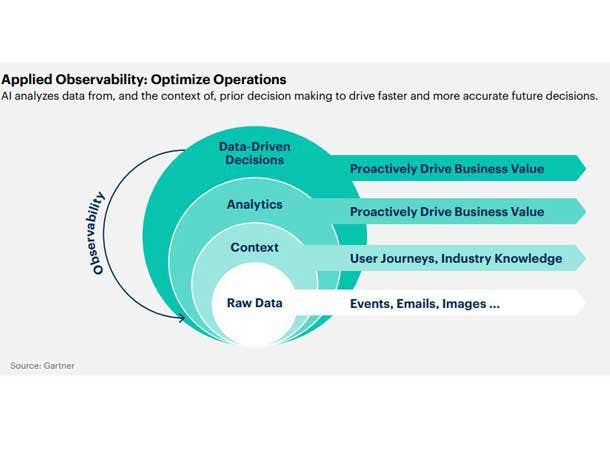
Applied Observability
Observable data reflects the digitized artifacts—such as logs, traces, API calls, dwell time, downloads and file transfers—that appear when any stakeholder takes any kind of action.
Applied observability feeds these observable artifacts back in a highly orchestrated and integrated approach to accelerate organizational decision-making.
When successfully executed, applied observability is “the most powerful source of data-driven decision-making,” said Gartner’s Karamouzis.
“Applied observability enables organizations to exploit their data artifacts for competitive advantage,” said Karamouzis “It is powerful because it elevates the strategic importance of the right data at the right time for rapid action based on confirmed stakeholder actions, rather than intentions.”
Applied Observability Use Case: Tesla
Tesla leveraged elements of applied observability. It offers vehicle insurance in several U.S. states to Tesla owners based solely on their “observable” real-time driving behavior. Tesla vehicles observe and measure driving behavior using sensors and Autopilot software to produce a monthly Safety Score. Tesla says that those deemed ‘average’ drivers based on their Safety Score could save up to 40 percent on their premium, and those with the safest scores could save up to 60 percent.
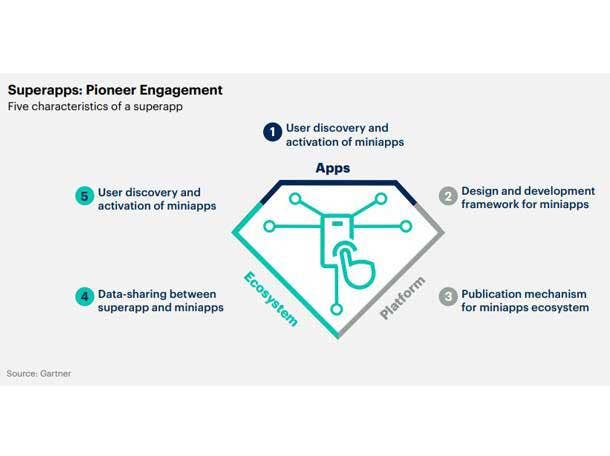
Super Apps
A “super app” combines the features of an app, a platform and an ecosystem in one application. It provides end users with a set of core features, along with access to independently created miniapps.
Super app’s not only has its own set of functionalities, but it also provides a platform for third parties to develop and publish their own mini-apps on.
“Although most examples of super apps are mobile apps, the concept can also be applied to desktop client applications, such as Microsoft Teams and Slack, with the key being that a super app can consolidate and replace multiple apps for customer or employee use,” said Francis Karamouzis, distinguished vice president and analyst at Gartner, in a statement.
By 2027, Gartner predicts that more than 50 percent of the global population will be daily active users of multiple super apps.
Super app Use Case: PayPay
PayPay is a Japanese payment provider with almost 50 million users. A key part of its growth strategy is to integrate the purchasing of third-party products and services within its super app, and it already provides third-party miniapps for buying cinema tickets, ordering food deliveries and bicycle sharing, alongside its own apps for financial management services and retail shopping.
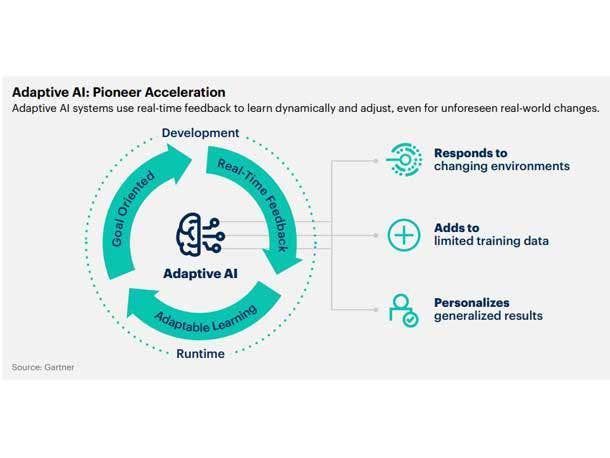
Adaptive AI
Adaptive AI systems continuously retrain models and learn within runtime and development environments based on new data to adapt quickly to changes in circumstances that were not foreseen or available during initial development.
They use real-time feedback to change their learning dynamically and adjust goals. This makes them suitable for operations where rapid changes in the external environment or changing enterprise goals require an optimized response.
Gartner said the value of operationalized AI is in the ability to rapidly develop, deploy, adapt and maintain AI across different environments in the enterprise.
Given the engineering complexity and the demand for faster time to market, it is critical to develop less rigid AI engineering pipelines or build AI models that can self-adapt in production.
Adaptive AI Use Case: Dow
U.S.-based manufacturer Dow deploys adaptive AI systems that use feedback on usage patterns and business value optimization to enhance enterprise analytics. This has resulted in a 320 percent increase in value generated by the analytics platform.
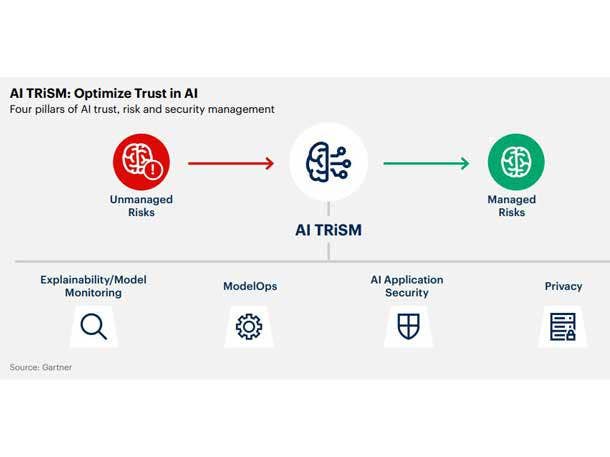
AI Trust, Risk and Security Management
Many organizations are not well prepared to manage AI risks, with Gartner citing a survey in the U.S, U.K. and Germany which found that 41 percent of organizations had experienced an AI privacy breach or security incident.
However, Gartner’s survey also found that organizations that actively managed AI risk, privacy and security achieved improved AI project results.
Artificial intelligence requires new forms of trust, risk and security management—which Gartner dubs TRiSM—that conventional controls don’t provide. New AI TRiSM capabilities ensure model reliability, trustworthiness, security and privacy.
In 2023, organizations should implement new capabilities to ensure model reliability, trustworthiness, security and data protection. AI TRiSM requires participants from different business units to work together to implement new measures.
AI Trust, Risk and Security Management Use Case: Abzu
Danish startup Abzu built an AI product that generates mathematically explainable models that identify cause-and-effect relationships. These allow Abzu’s clients to validate results more easily and have led to the development of more effective breast cancer drugs.
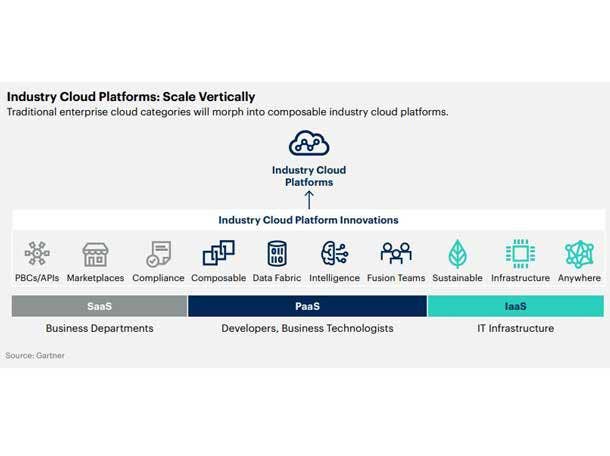
Industry Cloud Platforms
By 2027, Gartner predicts that more than 50 percent of enterprises will use industry cloud platforms to accelerate their business initiatives.
Industry cloud platforms offer a combination of SaaS, platform as a service (PaaS) and infrastructure as a service (IaaS) providing industry-specific sets of modular capabilities to support specific use cases.
Enterprises can use the packaged capabilities of industry cloud platforms as building blocks to create unique and differentiating digital business initiatives—providing agility, innovation and reduced time to market, while avoiding lock-in.
Industry clouds create value for organizations by incorporating cloud services traditionally purchased separately into pre-integrated but customizable industry-relevant solutions.
Industry Cloud Platforms Use Case: City of Hangzhou
Hangzhou, one of China’s most populous cities, partnered with Alibaba to build a platform to manage congestion and streamline daily city operations. Its “smart city brain” combined digitized infrastructure, a central data platform and massive applications. After implementation, the city slashed its congestion ranking, dropping from the fifth most congested city in China to out of the top 50.
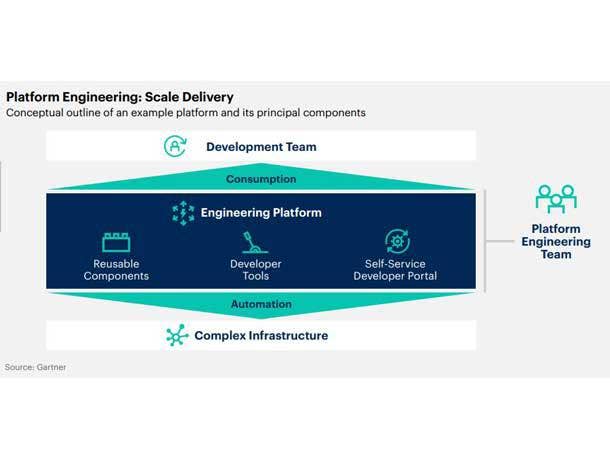
Platform Engineering
Platform engineering is about building and operating self-service internal developer platforms for software delivery and lifecycle management.
The goal of platform engineering is to optimize the developer experience and accelerate product teams’ delivery of customer value. To reduce friction for developers, data scientists and end users, companies have begun to build operating platforms that sit between the user and the backing services on which they rely.
Gartner predicts that 80 percent of software engineering organizations will establish platform teams by 2026, and that 75 percent of those will include developer self-service portals.
Platform Engineering Use Case: Nike
Nike has built composable platforms that unite strategic global business capabilities that are implemented by modular and composable technologies exposed through APIs. Nike finds the platform allows the company to respond more quickly to change, drive faster time to market, increase scalability and decrease operating costs.
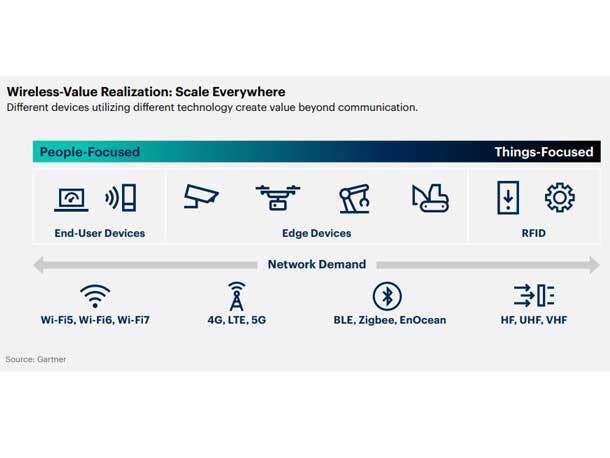
Wireless Value Realization
No single wireless technology will dominate the industry, Gartner said.
By 2025, Gartner predicts that 60 percent of enterprises will be using five or more wireless technologies simultaneously.
Enterprises will use a spectrum of wireless solutions to cater for all environments—from Wi-Fi in the office and services for mobile devices, to low-power services and even radio connectivity.
As networks move beyond pure connectivity, they will provide insight using built-in analysis and low-power systems that harvest energy directly from the network. This means the network will become a source of direct business value.
The integration of multiple wireless technologies will provide a more cost-efficient, reliable and scalable technical foundation that reduces capital expenditure, Gartner said.
Wireless Value Realization Use Case: Shufersal
Israeli retailer Shufersal is using power from the network to tag goods with low energy IoT chips. It uses these to track vegetables directly from the farm to the store shelves, providing supply chain visibility, inventory management and provenance information.
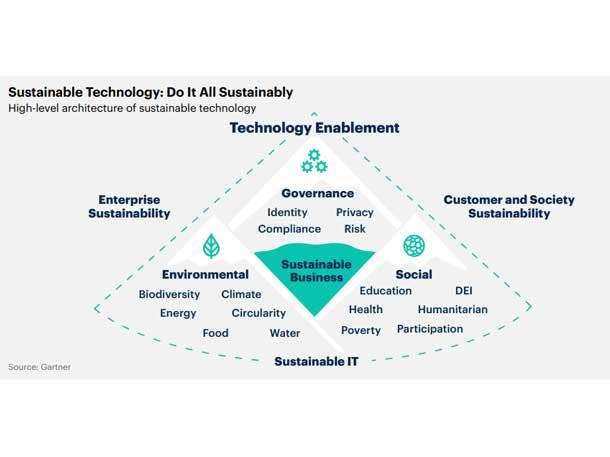
Sustainability
Sustainability traverses all of Gartner’s strategic technology trends for 2023.
In a recent Gartner survey, CEOs reported that environmental and social changes are now collectively a top three priority for investors, after profit and revenue.
This means that executives must invest more in innovative solutions that are designed to address ESG demand to meet sustainability goals.
To do this, organizations need a new sustainable technology framework that increases the energy and material efficiency of IT services; enables enterprise sustainability through technologies like traceability and renewable energy; and deploy IT solutions to help customers achieve their own sustainability goals.
Investments in sustainable technology have the potential to create greater operational resiliency and financial performance, while also providing new avenues of growth.
Sustainability Use Cases:
Smart solutions drive efficiencies and protect resources such as how Mitsui O.S.K. Lines uses AI-powered models to improve shipping efficiencies within the maritime industry.
Circular economy initiatives reduce waste, like how Apple is now uses robots for recycling.